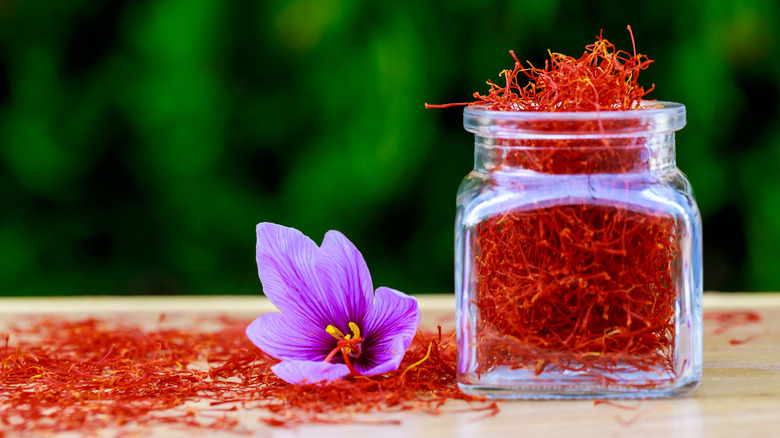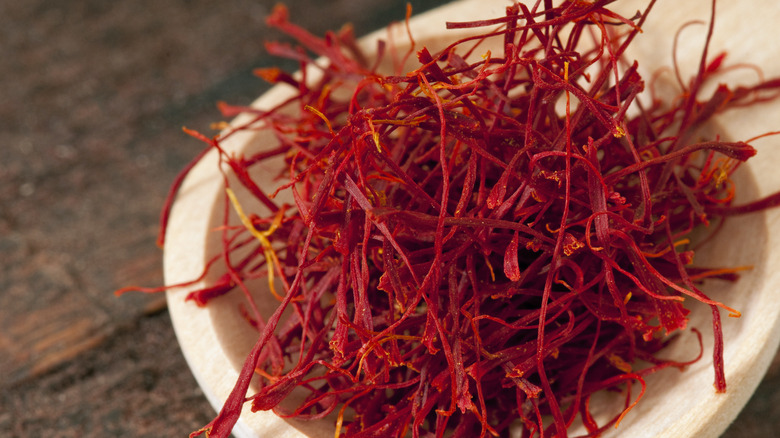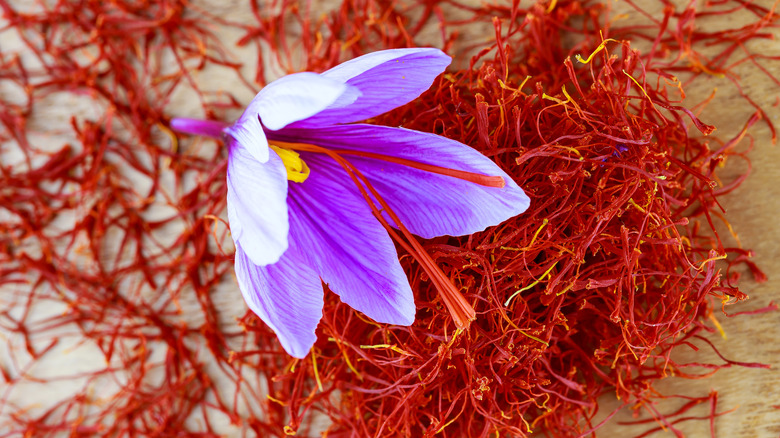Your Saffron Could Be Another Ingredient In Disguise
The thing about expensive food items is that you never know when you're actually getting the real deal. Grated parmesan is notorious for being laced with wood pulp, horseradish and mustard can pass off as wasabi with the help of food coloring, olive oil adulteration is a menace that has crossed continents, and saffron often has anything but real sprigs of saffron in it. Threads of corn silk, coconut filaments, and safflower thistles, or even dyed shreds of paper and horse hair are sold under the guise of real saffron.
Saffron is an ancient spice — and one of the world's most expensive ones. Retailing between $10 to $20 for a mere gram, saffron's hefty price tag has to do with its rarity and laborious harvest. Saffron is the stigma found in the middle of the purple-hued Crocus sativus (also known as saffron crocus or autumn crocus) flowering plant. Each flower only produces three strands of stigma, which means it takes roughly 150 flowers to produce just one gram of saffron. The costly price tag is starting to make sense now, isn't it?
To add to that, these flowers only bloom for one week every year – and even then, the orange-red stigmas of saffron are so fragile that they must be plucked carefully by hand. They are picked in the morning before the flowers open up and the sun damages the precious stigmas, and it takes one person about a day of work to gather a gram of saffron.
The adulterants that lurk inside saffron
Because saffron doesn't exactly grow in abundance and is a rare spice that must be plucked labor intensively by hand, these fragrant threads are one of the most adulterated foods on the market. To keep costs low, saffron strands — or red gold as they've been dubbed — may be mixed with other parts of the saffron flower such as white and yellow styles. Often, saffron stigmas are adulterated with dyed filaments from entirely different plants, including safflower, calendula, corn fibers, and pomegranate fibers, or non-plant filaments like silk fibers.
Some sellers may even add liquids like glycerin, honey, and oil, or minerals like gypsum, chalk, and barium sulfate to increase the weight of the saffron, thereby increasing its price as well. Powdered saffron may be adulterated with turmeric and paprika spices, yellow marigold flowers as well as crushed sweet fennel seeds. While some fake saffron powders and threads are colored with natural dyes, others may be laced with artificial dyes like Sudan I to IV that are carcinogenic and banned in the U.S. and the European Union, or Rhodamine B — a toxic substance that can lead to poisoning when consumed in large doses over a short period of time (via the Journal of Public Health Research). At best, you may be shelling out big bucks for something that isn't even remotely saffron, but — in some cases — you may be paying a lot of money for substances that are harmful to your health.
How to test your saffron
Considering the fact that saffron doesn't exactly come cheap, and to make sure that you aren't ingesting harmful chemicals, it's important to know how to weed out the real spice from dupes. When buying saffron, look for threads that are bulbous on one end. Good-quality saffron will have a honey-like, floral flavor and aroma with a touch of bitterness to it whereas dupes are more subdued with a metallic and earthy aroma that is similar to tobacco.
A good way to see whether your saffron is adulterated is to test it in water. Place a strand or two of saffron in hot water and observe how quickly the color of the water changes. If the threads turn white and bleed out too quickly into the water, you likely have a dupe in your hands. Real saffron takes between three to 10 minutes to dye the water yellow, and even then, the strands of saffron will still retain their red hue. Another way to test your saffron's quality is to soak it in cold water and rub it between your fingers. Real saffron will hold its shape (and color) whereas dupes may quickly fall apart.
While there are plenty of ways to gauge the purity of saffron, one of the most effective indicators is its price. Saffron ranks among the costliest spices that exist, so if you happen to find a suspiciously good bargain on its price, chances are that it's adulterated.



